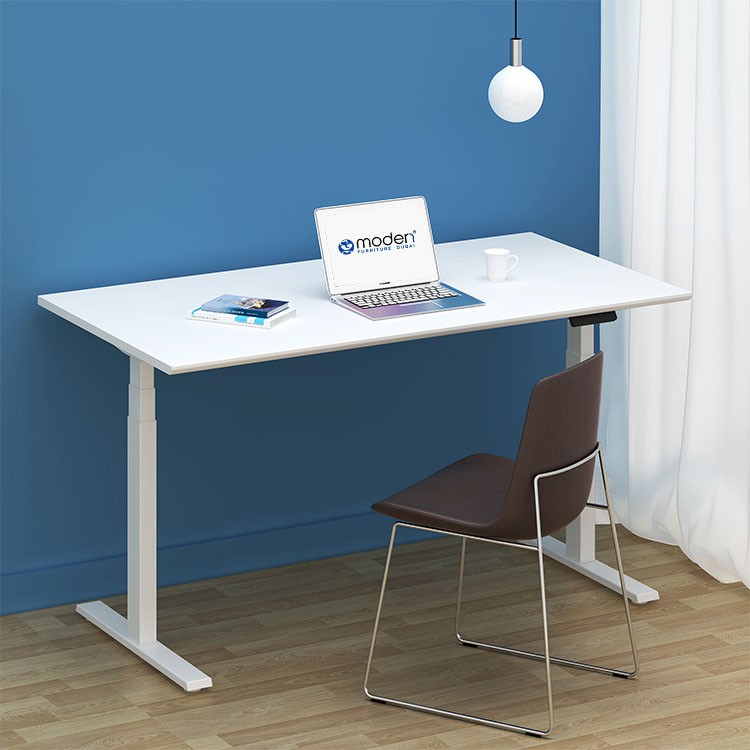
Desks That Work with All Chair Types: From Mesh to Leather
Introduction
Choosing the right desk doesn’t just depend on how it looks or how much surface space it offers—it also needs to work harmoniously with your chair. Whether you're sitting on a breathable mesh chair or a plush leather executive seat, the right desk will ensure both function and comfort are maximized. In this article, we explore how to select a desk that suits every chair type and why compatibility is essential for a productive workspace.
1. Height Adjustability is a Universal Advantage
A height-adjustable desk is one of the most adaptable choices for any type of chair. Whether your seat is low-profile or tall-backed, you can customize the desk’s height to ensure ergonomic posture, making it ideal for mesh, leather, or even gaming chairs.
2. Legroom Should Accommodate All Designs
Some chairs, especially executive or leather ones, come with extended armrests or bulkier bases. Choosing a desk with a wide and unobstructed leg area ensures that all chair designs can roll in and out comfortably without hitting support panels or drawers.
3. Compatibility with Chair Arm Heights
The distance between the desk surface and the chair arms matters. If your chair has fixed, elevated arms (common in leather or padded chairs), desks with adjustable or thinner tabletops offer more flexibility. This avoids awkward bumps and helps you maintain a proper seated posture.
4. Neutral Style Blends with Any Chair Finish
A versatile desk design—neutral colors, modern lines, and minimal hardware—works well across various chair styles. Whether your chair is made of mesh, leather, or fabric, a neutral desk won’t clash and can enhance a unified aesthetic.
5. Materials That Complement All Chair Types
Wood, metal, or laminate desks often offer a timeless look that pairs effortlessly with most chair materials. A premium standing desk with a matte or textured finish, for example, matches the sleekness of a mesh chair and the richness of a leather one.
6. Depth for Reclining or High-Back Chairs
Some chairs, especially high-back or reclining executive chairs, require more distance between your back and the desk edge. A deeper desktop ensures you can lean back comfortably while still accessing your monitor or workspace tools.
7. Built-In Features That Suit Different User Needs
Desks with built-in cable management, storage, or device charging ports work well no matter the chair type. These features reduce the need to lean or reach awkwardly, accommodating all styles from lightweight mesh chairs to bulkier executive ones.
8. Stability Supports All Chair Movements
A desk should remain stable even when paired with mobile or swivel chairs. Desks with solid bases or dual-motor mechanisms are ideal for ensuring the structure doesn’t shake or shift with frequent chair movements.
9. Supports Dynamic Workstyles and Seating Habits
If you switch between chairs throughout the day—say, from a task chair to a kneeling stool or even a standing mat—a flexible desk ensures consistency in your workspace. Look for designs that don’t limit your seating choices or posture shifts.
10. Suitable for All Room Styles and Chair Placements
Whether your desk is in a home office, coworking space, or executive suite, it should visually and functionally complement a range of chair types. Versatile designs make it easy to update your chair without needing a new desk each time.
Additional Considerations When Pairing Desks and Chairs
Know Your Chair’s Dimensions
Before selecting a desk, measure your chair’s height, armrest width, and reclining range. This ensures your chosen desk won’t obstruct your movements.
Consider Desk Edge Design
Curved or beveled edges offer better wrist and forearm support, especially for ergonomic chairs that promote close desk access.
Check Compatibility with Casters
Desks with wide bases and no skirting are best suited for chairs with wheels, allowing smooth rolling without obstruction.
Focus on Cable Routing
Desks with back openings or grommets work well for chairs with built-in tech or headrest speakers, keeping cords neatly routed.
Look for Modular Desk Designs
Modular desks adapt easily if you switch chair types, allowing for long-term flexibility without a full furniture overhaul.
Prioritize Finish and Texture
Matte or textured finishes prevent scratches from chair armrests and rolling bases, keeping both desk and chair looking pristine.
Pair Functionality with Style
If your chair is sleek and modern, your desk should echo those lines. If the chair is traditional leather, a desk with classic woodgrain balances the aesthetic.
Consider Footrest Compatibility
Some ergonomic chairs encourage footrest use. Choose desks with enough under-desk clearance to comfortably accommodate this.
Assess Movement-Friendly Shapes
Desks with curved fronts or L-shapes provide ergonomic space for different seated positions—ideal for both mesh task chairs and larger executive seats.
Evaluate Chair-to-Desk Transition Ease
Whether you’re moving between different chairs or postures, the desk should offer a smooth, obstruction-free transition that doesn't disrupt focus.
Recommended Product:

-
Bugal Pro Series Dual Motor Electric Height Adjustable Standing Desk
This desk is a versatile, tech-savvy option perfect for pairing with any chair—mesh, leather, or beyond. Its adjustable height, cable management, and sturdy dual-motor system make it ideal for a variety of seating preferences and work habits.
Final Thoughts
Finding a desk that pairs well with every type of office chair ensures long-term comfort, functionality, and design cohesion. Whether you're rotating between different seating options or simply upgrading your current chair, a universally compatible desk like the Bugal Pro Series is a smart investment in adaptability and style.
FAQ
Q: Can a standing desk work with leather executive chairs?
A: Yes, especially if it's height-adjustable. You can lower it to fit comfortably with plush executive seating or raise it for standing or alternate setups.Q: What’s the best desk for mesh chairs?
A: Mesh chairs pair well with minimalistic, breathable designs. Standing desks with good airflow and open leg space enhance comfort further.


